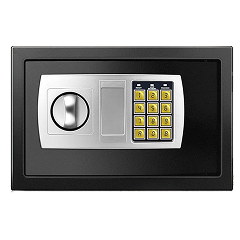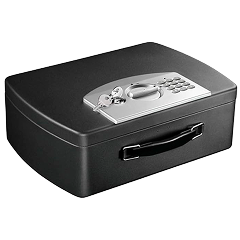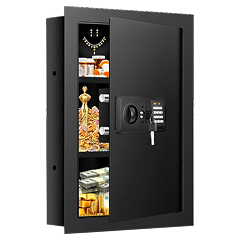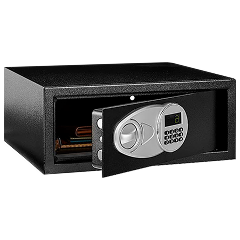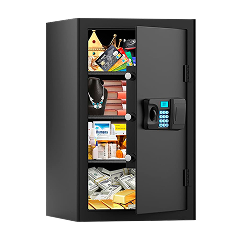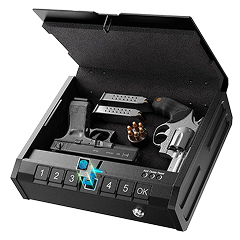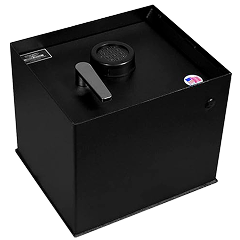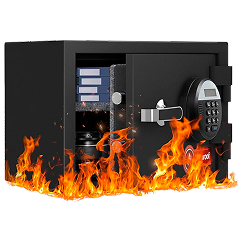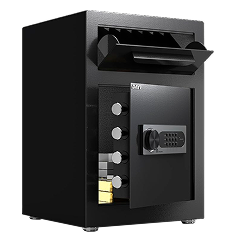People think about home safety after something goes wrong, like a break-in, a house fire, or that moment when you can’t find an important document and panic sets in. As an engineer and homeowner who’s lived with two different safes for several years, I’ve learned what matters in daily use versus what sounds good in product descriptions. My 80-pound combination lock safe sits in my basement, while a smaller fire-rated safe with a key lock safeguards my irreplaceable documents.
This guide focuses on the technical aspects and real-world performance factors that determine whether a safe actually defends your valuables. I’ll walk you through engineering standards, lock mechanisms, and construction details that separate effective safes from expensive boxes. For broader considerations and brand comparisons, check our main buyer’s guide; this mini-guide digs into the specifics that matter when comparing actual home safe models.
Understanding Safe Security Ratings and What They Really Mean
Security certifications matter because they show you what a safe actually withstands versus what marketing claims suggest. Independent labs attack these safes with real tools for specific time periods, then rate them based on how well they hold up.
RSC and B-Rate: Entry-Level Protection
The Residential Container (RSC) rating means the safe survived a 5-minute attack using hand tools like hammers, chisels, and pry bars. This covers opportunistic thieves who grab what they can quickly but won’t stop someone with time and determination. My 80-pound basement safe falls into this category. It’s adequate for defending documents and small valuables from casual theft, yet I’m realistic about its limitations.
B-Rate safes face a 30-minute attack with the same hand tools, plus cutting tools and small power drills. Construction involves thicker steel and improved door reinforcement. For many homeowners, B-Rate provides a solid defense against residential break-ins where thieves want to get in and out fast.
C-Rate and E-Rate: Serious Security
C-Rate testing involves a 30-minute attack using larger power tools, cutting torches, and drilling equipment. These safes feature much thicker steel walls and doors, sometimes with composite materials that resist drilling. E-Rate represents the highest residential standard, with 60-minute resistance against the same expert-grade tools.
The price jumps between B-Rate and C-Rate reflect the engineering required for this level of defense. Unless you’re storing high-value items or live in an area with sophisticated theft problems, C-Rate and above waste money for many people.
Verifying Legitimate Certifications
Real certifications come from Underwriters Laboratories (UL) or California Department of Justice testing. Find the certification number and lab name in the paperwork and ignore vague claims about “meeting standards.” I always verify numbers on the lab’s actual website before buying. Companies that skip real testing love words like “equivalent” or “comparable”. These are dead giveaways that they never paid for certification.
Fire Protection: Duration and Temperature Standards
Fire ratings tell you how long your documents will survive in a house fire, but testing standards reveal what “survival” actually means. Fire-rated safes get thrown into furnaces that reach 1700°F (house fire temperature), and internal temperature cannot exceed 350°F for paper documents to remain readable.
My small fire safe carries a 30-minute rating, which seemed adequate until I researched how long residential fires burn. I realized many house fires exceed 30 minutes before fire departments can fully extinguish them.
Differences between rating levels become clear when you compare what each standard actually defends against:
Paper begins to brown and become brittle around 400°F, and digital media like USB drives fail even sooner. Water resistance matters just as much as fire defense since sprinkler systems and firefighting efforts flood everything. My fire safe includes rubber seals around the door, yet I learned to store documents in waterproof bags inside after a basement moisture issue taught me that “water resistant” doesn’t mean “waterproof.” For truly irreplaceable documents like birth certificates or property deeds, I keep copies in both my fire safe and a bank safety deposit box because even the best home fire safe represents a calculated risk rather than absolute safety.
Lock Security Levels: From Basic to Advanced Protection
Each lock type brings different trade-offs between safety, convenience, and dependability that become obvious once you live with them daily.
Traditional Combination Locks
My basement safe uses a dial combination, and after three years of regular use, I appreciate its simplicity more than expected. Zero power requirements mean it works during blackouts, and nobody can hack it. Opening takes forever, though – I need 30 seconds minimum even with practice, and stress makes me mess up the sequence completely. Here’s something unexpected: taking time to open it actually helps me think through what I’m putting in or taking out, so I rarely walk away with the door hanging open.
Key Locks
My portable fire safe uses a key lock, which offers the fastest access but creates the obvious problem of key management. I store the key away from the safe, but then getting inside quickly becomes impossible. The lock still works fine after years of use, but I constantly worry about misplacing that key or having thieves grab it during a burglary. These locks make sense if you rarely open the safe or need to give family members access without teaching them combinations.
Digital Keypads
Digital locks solve the speed problem but introduce new failure points that conventional locks avoid. Battery backup systems vary wildly between manufacturers; some last years, others need replacement every few months. Dual authentication options, like requiring both a code and a physical key, provide excellent safety. However, convenience drops when you need both elements to access your valuables. The biggest concern with digital locks is complete failure during power outages or when batteries die, although many dependable units include backup key access.
Biometric Systems
Fingerprint scanners seem cool until you actually live with them. Dry hands, cuts, or just getting older throw off the readings, and you can only program 10-20 prints in total. The real problem? They’ll reject your finger when you’re in a rush or let in someone they shouldn’t recognize. Based on user reports and testing data, biometric systems work best as secondary authentication rather than the primary lock mechanism, although technology continues to improve each year.
Construction Details: Steel Thickness and Bolt Systems
Steel thickness directly determines how long a safe resists drilling and cutting attacks, with door thickness being more important than wall thickness since that’s where attackers focus their efforts. Entry-level safes use 1/8-inch steel that determined thieves can breach with power tools, while serious defense starts at 1/4-inch thickness.
Multiple bolts distribute prying forces across the door frame. My basement safe has four bolts versus cheaper models with just two that create weak points. Pry-resistant door designs use recessed construction where the door sits inside the frame, making it nearly impossible to get a crowbar between the door and the body. My safe’s 80-pound weight provides natural theft deterrence by eliminating grab-and-go theft. However skilled thieves with dollies can still move it, which is why anchor points matter more than weight alone.
Anchoring and Security Mounting
Pre-drilled anchor points transform a portable safe into a permanent fixture, although many homeowners skip this step and lose their theft defense. Even my 80-pound safe could be removed by two people with a dolly (or one strong person), which is why anchor points matter more than weight for real safety.
Heavy safes belong on floors where you can drill into concrete or solid wood joists. Light ones can go on walls if you hit enough studs to spread the weight. I can handle floor mounting myself with a hammer drill and concrete anchors, but wall jobs usually need someone who knows what they’re doing. Don’t skip the permit check; drilling into slabs or structural elements might need approval, and insurance won’t cover damage from bad installations.
Interior Capacity and Organization
Marketing dimensions lie consistently across the safe industry; manufacturers list external measurements without accounting for shelves, door thickness, and lock mechanisms that eat up usable space. My fire safe claims 0.8 cubic feet but holds maybe half that in actual documents once you factor in door depth and fixed shelf placement.
The shelf configuration affects usability more than the total volume, and fixed shelves create frustration when you need to store something slightly too tall. Start with a smaller safe to force prioritization of what actually needs defense, rather than buying oversized and filling space with items that don’t require secure storage.
Interior features add convenience but take up precious space:
- Interior lighting helps visibility, but requires power connections and reduces wall thickness
- Carpeted flooring prevents scratches on jewelry but holds moisture and odors
- Document slots organize papers well, but limit flexibility for other items
- Specialized compartments work great for their intended purpose, but become wasted space otherwise
- Door organizers maximize space usage but add weight and complexity to the door mechanism
Measure your actual items first, then add 25% for growth rather than buying based on advertised capacity numbers that never match real-world storage needs.
Battery Backup and Electronic Features
Battery backup systems separate dependable electronic locks from frustrating ones, although performance varies dramatically between manufacturers. Many digital locks run on AA or 9V batteries that last 1-2 years with normal use, although cold basements and frequent access drain them faster. Solid systems maintain full functionality for months on backup power, while cheaper units start acting erratically within days of losing main power. Low battery indicators range from helpful early warnings that provide weeks of advance notice to useless last-minute alerts that leave you scrambling for replacement batteries.
Water resistance for electronic components gets overlooked until moisture becomes a problem, although electronic locks need defense from both flood water and humidity. Sealed battery compartments and waterproof wiring separate safes designed for basement installation from those meant for climate-controlled areas. Automatic door opening mechanisms add convenience but create another failure point. Motorized systems work smoothly when new but tend to weaken over time, sometimes leaving you with a partially opened door that requires manual assistance.
Common Mistakes and What I Wish I’d Known Earlier
Here are the mistakes I made or witnessed other homeowners struggle with when choosing and using home safes:
- Buying too large initially — Oversized safes encourage storing items that don’t need defense, and make organization harder than smaller, purposeful storage
- Choosing convenience over safety for location — Placing safes in master bedrooms or home offices makes them easy targets during break-ins when thieves know where to look
- Forgetting backup access planning — Not telling trusted family members combinations or key locations creates problems when you’re unavailable during emergencies
- Ignoring humidity control needs — Basements and garages require moisture defense that manufacturers mention briefly but don’t emphasize enough
- Skipping regular lock testing — Combination locks can drift over time and electronic locks develop quirks that you’ll discover at the worst possible moment
- Underestimating ongoing costs — Battery replacements, dehumidifiers, and eventual lock servicing add up over the safe’s lifetime
- Assuming fire ratings cover everything — Paper survives, but photos, USB drives, and some plastics get damaged even within rated temperature limits
Budget Considerations and Value Analysis
Safe prices jump dramatically between levels, although understanding what drives these costs helps you spend money on features that actually matter.
Price Ranges and Cost Drivers
Small fire safes with basic key locks run $50-$150, but you’ll pay $200-$400 for anything with real security ratings like RSC. Want B-Rate protection? That’ll cost $800-$2,000. C-Rate safes start at two grand, and the sky’s the limit from there.
Here’s what drives these prices: doubling steel thickness from 1/8-inch to 1/4-inch basically doubles what you pay. Fancy locks and better fire ratings tack on another $200-$500 easily. The lock itself eats up about a quarter of your total budget, so swapping from a simple key to digital with battery backup can add hundreds to the price tag.
Investment Priorities
Simple defense makes sense for many homeowners storing documents and small valuables, while higher-end features pay off only when securing items worth significantly more than the safe itself. I’d rather own two straightforward safes in different locations than one expensive safe that becomes a single point of failure.
Digital locks and fire ratings deserve priority over thick steel for home use, since house fires happen more often than sophisticated break-ins. Biometric locks and C-Rate safety make sense when storing firearms, large amounts of cash, or jewelry worth thousands of dollars.
Long-Term Value Analysis
Cheap safes come with one-year warranties, and expensive ones promise lifetime coverage, but what really matters is whether the company actually helps when something breaks. Repairs often cost more than buying new anyway. Quality safes last decades with basic care and hold their value. Junk safes break within a decade, and fixing them makes no financial sense.
The cost per cubic foot analysis reveals that mid-range safes offer the best value. Budget models seem cheap until you factor in replacement costs, while premium safes cost too much per unit of storage unless you need their specific features.
Which Home Safe Is Right For You?
Your primary use case determines everything else about your safe selection. Document defense requires a fire rating over thick steel, while jewelry storage needs ratings over fire defense. Plan to spend $300-$600 on something that actually works. Focus on 60-minute fire ratings and RSC or B-Rate certifications instead of fancy features you’ll never use. Skip the bells and whistles; get locks that work and fire ratings that matter.
Multiple smaller safes beat one large unit because they let you match defense levels to contents and distribute risk across locations. Documents go in my fire safe, valuables in my security safe. Splitting things up beats putting everything in one expensive target. Buy a basic fire safe first, then add security storage later as you figure out what you actually need. This approach saves you money upfront and lets you adapt as you learn how safes fit into your routine.


